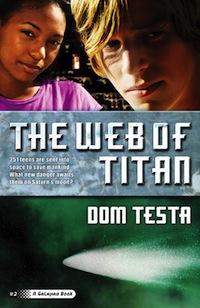A few weeks ago the U.S. team actually won a game in World Cup soccer. In 2005, Giacomo, a 50-1 three-year-old won the Kentucky Derby and paid over $100 on a $2 ticket. During the last century the New York Jets won a Super Bowl, and the New York Mets won a World Series. Long-shot Frank Shorter won the Olympic Marathon in 1972 in the same country where Jesse Owens won the 100 meter dash in 1936 to prove to Adolf Hitler that blonds don’t necessarily have more fun. Miracles like these happen every so often in the sports world. In addition, people with fatal diseases occasionally have seemingly miracle cures, and lucky folks do win lotteries. And, just about as frequently as these events happen, a major publisher picks up a self-published novel, releases the book, and a star is born.
The Comet’s Curse, the first book in Denver radio personality Dom Testa’s young adult science fiction series, won the Grand Prize in a Writer’s Digest contest for self-published novels in 2006. Last year Tor Teen made The Comet’s Curse available to the general public to much critical acclaim, and a fan movement among young readers has been gaining momentum ever since (check out clubgalahad.com). The second installment, The Web of Titan, was released in the last week of June.
In The Comet’s Curse, Earth passes through a comet’s tail, leaving behind a deadly virus that only affects adults. In a few years the human race will die out unless something is done to save it. Governments and scientists around the world join forces to build the starship Galahad and to select the 251 teenagers who will colonize a distant planet. Each of the adolescents, who will be 15 and 16 years old when the ship disembarks, is chosen for his or her intelligence and various other strengths and abilities in engineering, farming, medicine and other areas crucial to the success of the mission.
Most of the novel is a vehicle to set up the series and introduce the major characters, especially the ship’s captain, Triana Martell, and Roc, a wisecracking computer with a far different personality from 2001’s HAL.
In addition to all the technical and emotional difficulties with leaving Earth, the crew face down a pathological saboteur once they finally get underway.
Now, on to The Web of Titan:
Part of the plan to provide acceleration for Galahad is gaining a slingshot effect from Saturn’s largest moon. Several scientists living on a space station orbiting Titan are among the few surviving human adults. Among the last communications from the scientists was a set of instructions for the crew of Galahad to pick up a “transport pod” that was ejected from the station. Mysteriously, there is no information as to why the pod is important, only that salvaging it may make the difference between success and failure.
As Galahad nears its appointment with Titan and the pod, several of the most important teens come down with a strange illness. One of them begins speaking in tongues, repeating the same message in a dozen of the home languages of the stricken members of the crew. The ship begins to accelerate far more quickly than the slingshot effect provided, and it is nearing a point where its engines will explode.
There is obviously more to Titan than anyone previously guessed, and the surprise that occupies the transport pod provides the clue to what that is.
Triana, her council of advisors and Roc must make several important split- second decisions, or the 251 teens and the human race will be doomed.
Reminiscent of some of Heinlein’s adolescent science fiction, Testa has succeeded in creating a believable spaceship environment and a likeable and engaging cast of characters who present an element that may be unique, or nearly so, in galactic colonization—no adults at all. He even hints at a couple of blossoming romances that should make for some interesting problems in coming episodes.
However, as a former high school teacher with over 30 years of experience and many thousands of students, I have one criticism. Where are the sex, drugs, rock and roll…and the fistfights? There is one concert on board in the second book (not exactly rock and roll), but that is hardly enough. By the time The Web of Titan comes around, the members of the crew are nearing 16 and 17 years old. We have here 251 bundles of raging hormones. Of course, these kids are the cream of the crop. But this also means that they would have no problem figuring out how to ferment the crops into some great booze or synthesize some dandy drugs. Remember, there are no adults around to stop them. And I am sure that a lot more would be going on under the stars in the farm domes than just growing crops—we’re talking some serious partying here, and even Testa’s target young adult audience would expect that.
Don’t get me wrong. I think both of these books were pretty terrific, and the plots and characters work—which is most important. But let’s hope that in the next book, The Cassini Code, these saviors of mankind begin to act a little more human.
Mark Graham reviewed books for the Rocky Mountain News from 1977 until the paper closed its doors in February 2009. His “Unreal Worlds” column on science fiction and fantasy appeared regularly for over two decades. He has reviewed well over 1,000 genre books. If you see a Rocky Mountain News blurb on a book, it is likely from a review or interview he wrote. Graham also created and taught Unreal Literature, a high school science fiction class, for nearly 30 years in the Jefferson County Colorado public schools.










